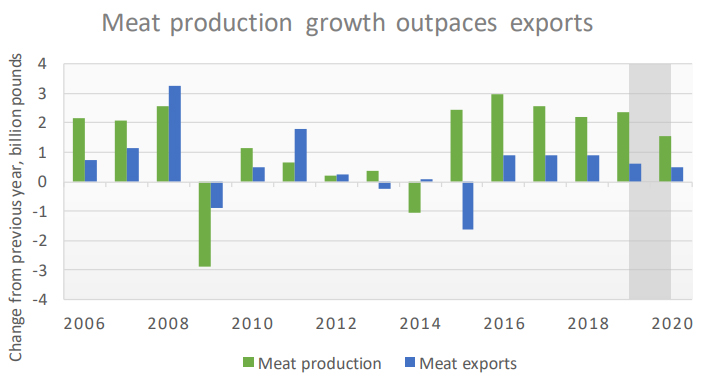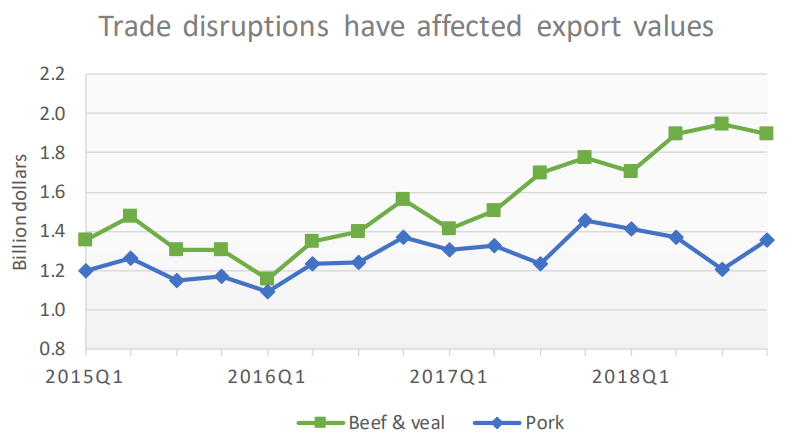5 Factors Driving the Livestock Outlook

Livestock farmers are facing a combination of headwinds and tailwinds—as well as a lot of unknowns. Issues such as meat supplies, global diseases and low profitability will all weigh on the future of the industry, says Scott Brown, University of Missouri economist.
Livestock industry net returns are expected to remain mostly flat through 2020, below the record highs of 2014-15, but above levels prior to 2011, according to the 2019 U.S. Baseline Outlook report compiled by Food and Agricultural Policy Research Institute (FAPRI) at the University of Missouri. Strong consumer demand for meat and dairy products drive projected increases in the long term, though many uncertainties exist regarding economic and trade issues.
Brown outlines five key trends producers should monitor going forward.
Meat Supplies
Meat production—beef, pork and chicken—will increase again in 2019, the fifth consecutive year of output gains exceeding 2 billion pounds, per FAPRI’s estimates. While meat export growth has been positive since 2016, it has not kept pace with the increases in production.

Source: FAPRI
FAPRI estimates point to a growing concern regarding the amount of additional growth that can be sustained without sharp price declines.
Disease Issues
Especially for the pork industry, disease issues remain critical. Production losses from African swine fever (ASF) have eclipsed initial estimates, according to a recent Rabobank report. In 2019, Rabobank expects Chinese pork production losses of 25% to 35%, creating new challenges and opportunities for animal protein exporters.
While that estimate may be a bit high, Brown notes, the effects of African Swine Fever remain unclear.
Weather Outlook
Drought conditions in 2018, a wet fall and long winter have caused livestock producers to stretch historically thin hay supplies. USDA’s Feb. 8 USDA Hay Stocks report showed Dec. 1, 2018, hay stocks at 79.06 million tons, down 6.4% from one year ago. The Dec. 1 hay inventory was the lowest total since 2012.
Brown expects many producers were forced to feed low-quality hay, which could affect the upcoming calf crop.
“The weather has been a key driver of livestock outlook,” he says.
Domestic Demand
U.S. consumers’ appetite for meat has been a bright spot for livestock producers, Brown notes. Low unemployment and a strong U.S. economy are helping fuel record domestic meat consumption.
Yet, Brown says, he’s carefully watching for signs that domestic demand strength for meat is changing.
“What happens the day consumers decide fat is bad for them again? Play that out in your mind; it’s not such an optimistic situation,” he says. “If this economy turns into a recession, what happens to meat demand?”
Trade Outlook
Trade disruptions have affected livestock export values. Though pork export quantities grew by more than 4% in 2018, the value of total pork exports fell by nearly 5% in the second half of the year relative to 2017, FAPRI reports.

Source: FAPRI
“Trade agreements and tariffs are critical to meat exports,” Brown says. “What we did yesterday doesn’t matter, it’s what happens tomorrow that matters.”
While the presence of ASF in China could support stronger pork exports in coming months, Brown is watching two issues.
“No. 1 is I don’t think the Chinese will import 1 lb. of pork for 1 lb. they no longer produce. I think they’ll find substitutes,” he says. “No. 2, who gets that trade?”
Overall, Brown says the abundant meat supplies are a negative force for the livestock outlook, while the disease issue and domestic demand are positive. The two biggest unknows are weather and trade agreements.
Read More
Analysis: FAPRI Farm Income Outlook Less Positive Than USDA
FAPRI: Continued Pressure on Farm Finances







